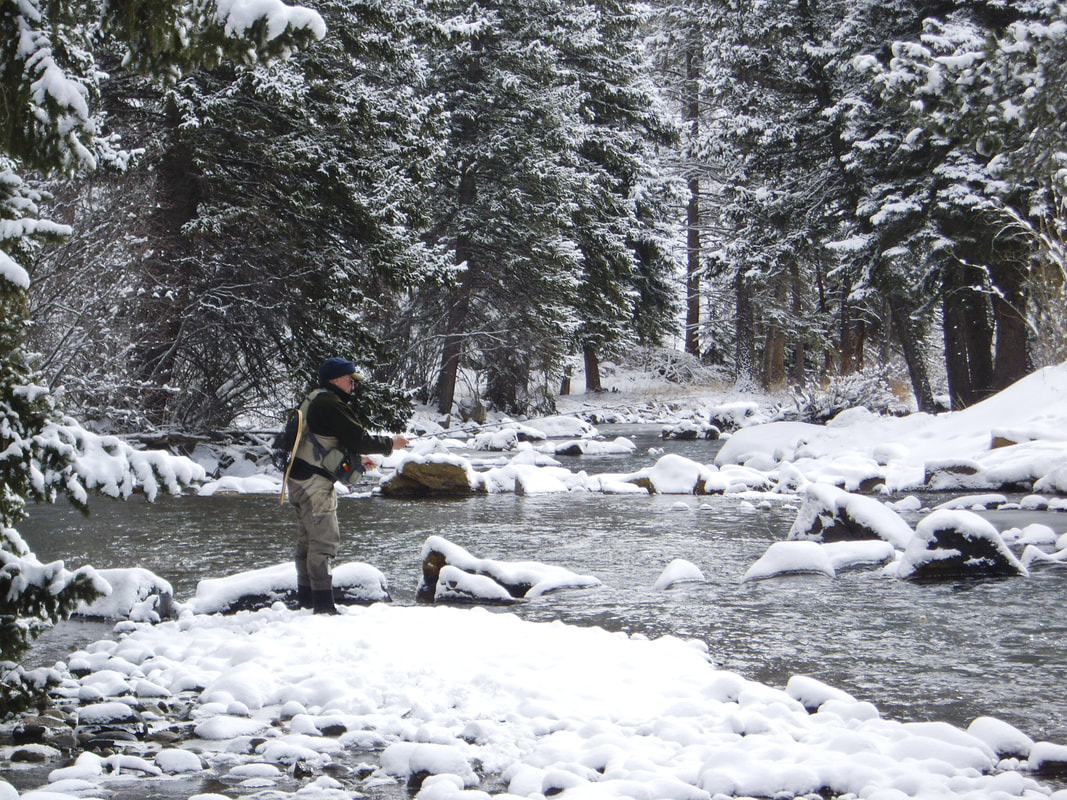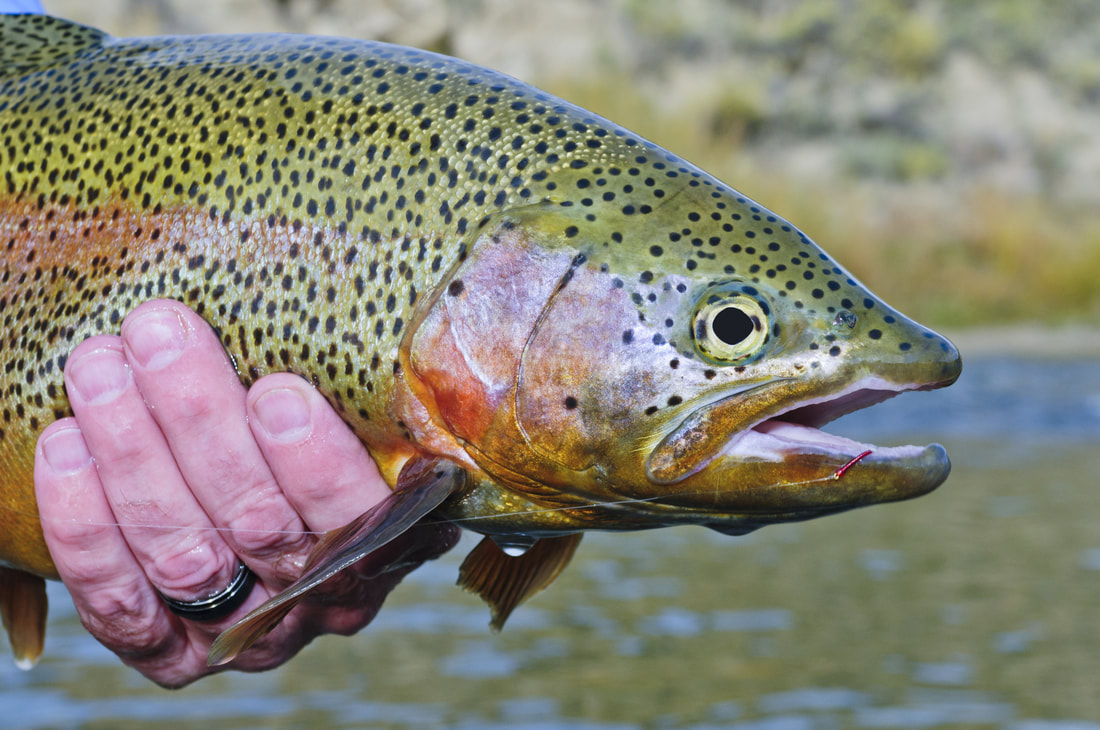Go-To Midge Larva for the Winter Season
With the winter-season quickly approaching, fly-fishers need to break out their arsenal of tiny flies. For the next several months, midges make up thebulk of a trout’s diet. I strongly recommend that you familiarize yourself with a midges’ lifecycle (larva, pupa, and adult) and carry patterns to imitate the various stages of their development.
Midge larvae can be identified by their wormlike appearance. Larva are characterized by their slender, slightly curved, uniform abdomen with visible segmentation. Midge larvae look like little segmented tubes! Another distinguishing feature is their small head which is easily imitated with a few wraps of tying thread. Most larvae you’ll encounter on streams range between one-eighth and one-half inch in length.

Throughout the winter months, anglers need to carry a thorough assortment of midge larvae in size 18-20. Pale-olive and red larva are among the top producers.
Midge larvae are commonly found in cream, tan, gray, pale-olive and red. They live in the substrate of our rivers and attach themselves to aquatic vegetation, rocks, and branches. Some midge larvae burrow into mud and silt.The amount of midge larvae that reside in our streams is mind-boggling! According to Leonard C. Ferrington, Jr., a professor at the Department of Entomology at the University of Minnesota, “Midge larval densities depend on month of year, productivity of stream, and kinds of stream bottom substrates. Typical densities, however, may range from 800 to 2,000 larvae per square meter.”
Midge larvae living in low oxygenated areas of a trout stream are called blood worms or blood midges. They are blood-red because they contain an oxygen carrying pigment called hemoglobin that allows them to survive in areas with little or no oxygen.

This rainbow was fooled with a Bead Head Red Midge Larva. Midge larvae living in low oxygenated areas are referred to as blood worms or blood midges.
Midge larvae are an important food source for trout year-round because they get knocked loose from the substrate and drift continuously in the water column, a phenomenon referred to as constant drift. A constant supply of midge larvae is especially important for opportunistic trout when other aquatic insects are inactive. In most cases, opportunistic trout do not waste any time grabbing a midge larva that is floating helpless in the current.
Here are a few my favorite midge larva patterns that have proven themselves over the years. I strongly recommend adding these to your midge selection if haven’t already done so.
Dorsey’s Pale-Olive Larva
Hook: Size 18-20 Tiemco 2487
Thread: 8/0 Light Cahill Uni-Thread
Abdomen: Clear Hareline Micro Tubing
Bead Head Red Larva
Hook: Size 18-22 Tiemco 200R
Bead: red glass extra small
Thread: 8/0 red Uni-Thread
Abdomen: Red Hareline Micro Tubing
Miracle Nymph
Hook: Size 18-22 Tiemco 100
Thread: 6/0 white Danville
Underbody: 8/0 black Uni-Thread
Abdomen: 6/0 white Danville
Head: 8/0 black Uni-Thread
Mayer’s Tube Midge
Hook: Size 18-22 Teimco 2488
Thread: Red 8/0 Uni-Thread
Abdomen: Clear Hareline Midge Tubing with red Ultra Wire inserted into tubing
Head: Black 8/0 Uni-Thread
McCannel’s Neon Nightmare Midge
Hook: Size 18-22 Tiemco 2488 H
Thread: 70 denier white UTC Thread
Rib: 70 denier orange or pink UTC Thread
Clear Coat: 5 minute epoxy
Midge Larva Fishing Strategies
Larvae doesn’t require the same amount of finesse as it does with pupae or adults.I typically dredge my larvae imitations close to the substrate when there are no obvious hatches.My nymph rig includes three flies: One attractor (red midge larva, egg pattern, etc.) and two droppers. Make sure you check your local fishing regulations pertaining totandem rigs. In some states you can fish with three flies while others you can only use two.
Egg-midge combos are effective a large percentage of the winter because there are always a few trout spawning in our streams. Oftentimes the egg-pattern draws attention to the midge imitation. I frequently use a red midge larva as an attractor with the same goals in mind.
If there are no obvious hatches, I’ll trail two larva imitations off my attractor. To get my flies down in the current, I place a #6 split shot on my leader about 12 inches above my first fly. Then I put some JP’s Nymphing Mud over the split shot to get my flies to the desired depth. If you’re not occasionally picking a little moss off your nymphs you’re probably not deep enough!
Once I begin seeing a few adults buzzingaround the stream, I’ll swap out my bottom dropper with a pupae imitation. Some of my favorites include: Size 20-24 Black Beauties, Top Secret Midges, Manhattan Midges, Medallion Midges, Minute Midges, Jujubee Midges, and South Platte Brassies. This allows me to cover my bases and imitate both larvae and pupae, the predominant food organisms on any given day during the winter months.
Between November and March it is important to concentrate your efforts in the slow, deep runs and pools. This is precisely where trout overwinter, trying to maximize their food intake while expending the least amount of energy. The best fishing is between 11 a.m and 3 p.m. when the water temperatures are conducive to finding a few feeding trout.

I am a ranger on the North Slope of Pikes Peak (May through October). Our fly fishers ask me all the time how large a midge larva I would recommend on North Catamount Reservoir fishing. Your thoughts on that?
You could fish larger Chironomids up to a size 14 down to tiny midge larvae in size 20 or 22. A size 20 red larva is always a great option on a lake…
Pat, when you fish a larva and a pupa, how do you rig them, bend of hook, or eye to eye? Also, is the weight to be above both flys, or between them? Thanks for all you do for fly fishing. Gene
I run the larva as my lead fly and trail the pupa off the bend. I put the lead above the flies about 12 inches. Thanks for your support.
Hi Pat, do you ever use a technique using a leader trailer with a variable number of shot attached to adjust thr depth of the midge larvae? (I forget what it’s called) Thanks for sharing your knowledge.
I do not. I just use a tandem rig, with three flies in Colorado.